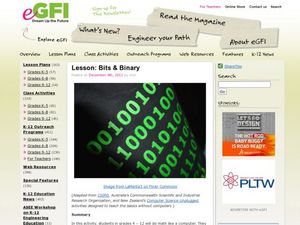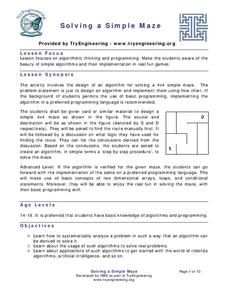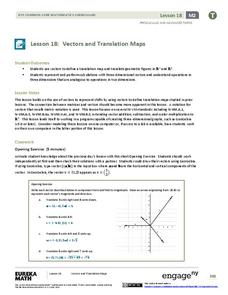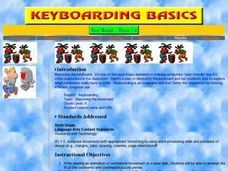Curated OER
Alice Computer Programming
Middle schoolers explore multimedia components. In this science inquiry lesson, students read "Invitation to the Game" by Monica Hughes and they use the Alice Computer Programming System to better understand population dynamics.
NASA
Explore Mars With Scratch
Learn what it takes to explore Mars in the comfort of a classroom. Individuals experiment with computer programming using a free online resource while learning about the factors affecting Mars Rover explorations. They create a...
DiscoverE
Coding Without Computers
See what it feels like to be a robot. Scholars use programming vocabulary to program a human robot and test out their codes by acting them out. The code should result in stacking six cups into a pyramid.
Curated OER
Irregularly Scheduled Programming
Students examine their favorite holidays and how they are celebrated. After reading an article, they discuss the length of television programming for the Super Bowl. In groups, they create their own television programming relating to...
eGFI
Bits & Binary
Youngsters love to write on their hands, and in this fabulous activity they are actually asked to. Using numbers written on the tips of their fingers, they will learn how the binary number system works. This hands-on activity is a...
Mascil Project
Pottery
Don't cry over broken pottery. A cross-curricular lesson plan challenges pupils to consider how to restore ancient pottery. Using a computer program and their knowledge of transformations, they come up with a way to recreate the original...
Curated OER
Computer Titration Lab Simulation
High schoolers perform a lab simulation for a titration of monoprotic and diprotic acids. In this titration simulation lesson plan, students use a computer program to neutralize an acid with a base and compute the unknown concentration...
EngageNY
First-Person Computer Games
How do graphic designers project three-dimensional images onto two-dimensional spaces? Scholars connect their learning of matrix transformations to graphic design. They understand how to apply matrix transformations to make...
TryEngineering
Solving a Simple Maze
Solve a maze ... from a robot's point of view. In the lesson plan, your scholars build a small, simple maze from cardboard and then find a route from the start point to the finish point. They write an algorithmic process that a robot...
NASA
Let's Investigate Mars
Take your science class on a hypothetical field trip to Mars with an engaging astronomy lesson. After first learning about NASA's Mars rover missions, young scientists plan their own scientific investigations of Earth's...
Curated OER
Computer Software and ACS Materials for Chemistry
Students use computer software to simulate chemistry laboratory experiments. In this experimenting using computer software lesson plan, students use software called "The One Computer Classroom" to investigate wave simulations as a whole...
TryEngineering
Solving Problems with Decision Trees
Combat crime with computers. The instructional activity teaches young computer scientists about decision trees and how to use them. They consider telecommunications subscriptions and how decision trees can help detect fraud.
Curated OER
The Power of Words in Charlotte's Web
"How can a few good words save a pig's life?" Posed with this question, your ELD students explore E.B. White's Charlotte's Web in a meaningful, valuable way. By analyzing specific word choice from the book, especially the excerpts...
TryEngineering
Arduino Blink Challenge
Who knew turning a light on and off could be so complicated? In the instructional activity, pupils use Arduino boards to learn about computer codes and programs. They program an Arduino to make a light turn on and off at certain time...
EngageNY
Vectors and Translation Maps
Discover the connection between vectors and translations. Through the lesson, learners see the strong relationship between vectors, matrices, and translations. Their inquiries begin in the two-dimensional plane and then progress to the...
Curated OER
Feature Column: Virtual Field Trips
Students discover ways to stay healthy by utilizing Internet education software. In this computer technology instructional activity, students investigate Internet programs that simulate a field trip by showing images and video....
Curated OER
Variable Arrays
Twelfth graders compare and contrast variables and arrays. Using data, they enter the information into a spreadsheet and an array to compare how they appear. To end the lesson, they complete basic programs in which they use arrays.
Curated OER
Radio Program #7: The Impact of Early Radio
Students examine and interpret the experiences of persons who lived in the early days of radio. identify the technology, program content, and social aspects of early radio listeners. They interview parents for their experiences. Students...
Curated OER
Yummy Math
Young mathematicians use bags of Skittles to help them gain practice in graphing and organizing data. They work in pairs, and after they have counted and organized their Skittles, they access a computer program which allows them to print...
Curated OER
Transformations and Matrices
There are four activities in this extensive lesson plan covering the identity matrix and scaling, the linear representation of translations, the linear representation of rotations, and reflections. In small groups, they use the Cabri II...
Curated OER
Mastering the Keyboard
Sixth graders view an animated program showing how the continents fit together millions of years ago. In groups, they compare and contrast the distribution of rocks and fossils based on how the continents fit together. After reading a...
Curated OER
Have I Been Hacked?
Students investigate how effective SNEAK strategies are in detecting hackers. In this technology lesson, students explain the ethical issues about hacking. They graph and analyze their experimental results.
Curated OER
E3 Ret Lesson Plan
Students explore friction. In this physics lesson plan, students will cover metal blocks with film to determine the changes caused by static and kinetic friction.
TryEngineering
Give Binary a Try!
Digital, analog, and now binary clocks? The lesson teaches individuals how to interpret binary code. They use an online software program to read binary clocks.























